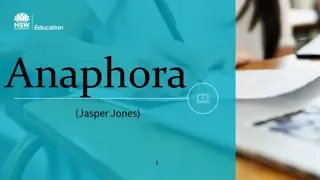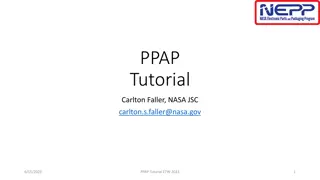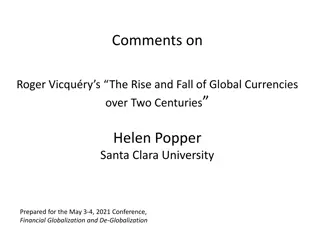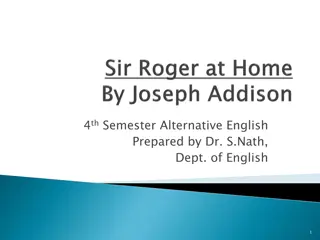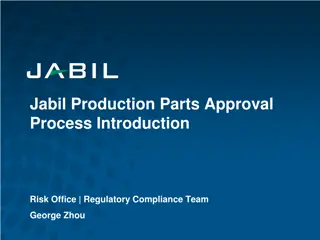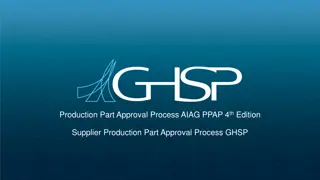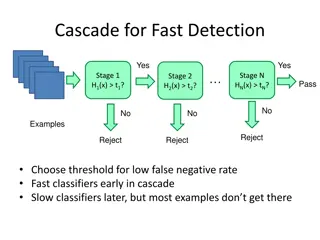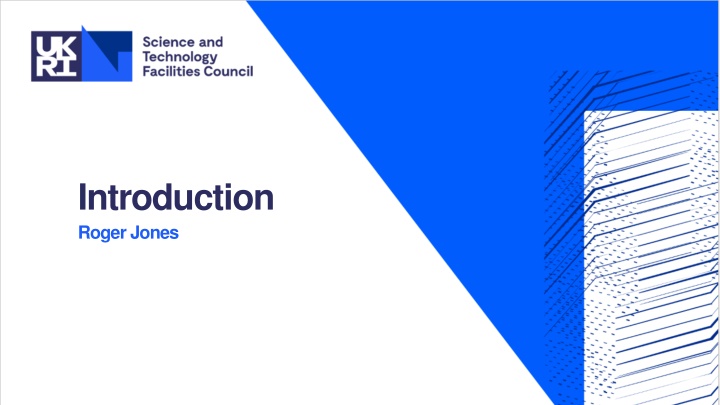
STFC Particle Physics Advisory Panel Updates and Roadmap Process
Stay updated on the latest developments with STFC's Particle Physics Advisory Panel (PPAP). Discover new panel members, upcoming roadmap milestones, and the nature of the roadmap process. Engage in the PPAP scope and understand how technology plays a crucial role in achieving physics goals. Learn about the timeline for the roadmap and the importance of UK engagement in international exercises.
Download Presentation

Please find below an Image/Link to download the presentation.
The content on the website is provided AS IS for your information and personal use only. It may not be sold, licensed, or shared on other websites without obtaining consent from the author. If you encounter any issues during the download, it is possible that the publisher has removed the file from their server.
You are allowed to download the files provided on this website for personal or commercial use, subject to the condition that they are used lawfully. All files are the property of their respective owners.
The content on the website is provided AS IS for your information and personal use only. It may not be sold, licensed, or shared on other websites without obtaining consent from the author.
E N D
Presentation Transcript
Introduction Roger Jones
Zoom Etiquette Please set your microphone to mute as default. Use the raise hand and chat functions during the breakout sessions to make comments/contributions/ask questions. Try to make your comments as concise as possible we are large in number and short on time! There is limited capacity to answer questions in the plenary sessions owing to the number of people in the meeting, so please use the chat function to ask questions and we will endeavour to pick these up in real time or answer them after the meeting.
PPAP membership In 2020 STFC introduced a new panel application process, that is more transparent and consistent with the principles of equality, diversity and inclusion. Good applications were received for the PPAP, but numbers were still small. The community are encouraged to apply to future rounds. We thank the outgoing PPAP members: Joanne Cole, Pawel Majewski, and Matthew Malek We welcome three new PPAP members: Adrian Bevan, Monica D Onofrio, and Ruben Saakyan; new addition, Kim Palladino Reminder: Matthew Needham will be the new chair of the PPAP from the Spring Roger Jones will continue to support the panel to produce to its new roadmap
Reminder of Roadmap Process PPAP has been asked to provide a new Particle Physics roadmap in response to the ESPPU. Establish UK position following the ESPPU to input into other exercises going on in Europe through ECFA and LDG, and worldwide. PPAP Roadmap timeline: 28 September community meeting Slides from that meeting for summary of ESPPU update addition slides here November current experiment update meeting This is the current meeting, 20th November December/January initial drafting, consult with Nuclear and Astroparticle panels etc New Year community meeting to discuss the draft roadmap Date now set, 19th February April 2021 roadmap published Presentation of near final at STFC Town Meeting
Nature of process PPAP roadmapping is not Dragon s Den! Attempt to establish the location and weight of UK ambition and interest. Likely form of roadmap There will not be a single ranked list But some degree of prioritisation for UK Not necessarily financial, could also be potential for cross council working, strong international partnerships, strong technology development etc. Almost certainly we will produce several scenarios Many factors are external to the UK Important for the UK to engage in international exercises Common themes and common developments are likely to be lower risk and higher reward Important to recognise synergies and the steps needed to prepare for future experiments (i.e. R&D)
PPAP Scope PPAP looks at the (particle) physics goals and roadmap. Technology matters, but as an emergent need form those goals, not an end in itself PPAP ~= PPTAP! PPTAP is a new committee, established by programmes to inform the European roadmapping PPAP and the community should communicate technology needs to PPTAP By chance we have one cross member More permanently, the TAB sits parallel to Science Board in STFC Looks in a cross-STFC way at technologies
Written inputs Written inputs can help the panel, but are not required. Solicited in Community meeting on 16th September, encouraged early submission (soft target 18th October) Subsequent much later target of 27th November, announced in regular HiPhy on 4th November No pro-forma We will now give brief topical summaries of the state of play ~ by Monday No suggestion we favour earlier submissions! This is for information only Later submissions will be noted
European Strategy key points and current UK programme
European Particle Physics Strategy 2020 The European Strategy has seven sections: Major developments from the 2013 Strategy General considerations for the 2020 update High-priority future initiatives Other essential scientific activities for particle physics Synergies with neighbouring fields Organisational issues Environmental and societal impact Overall, the UK programme aligns reasonably well with the European Strategy, but there is more we can do. It will be important for the future UK programme to be focussed and to identify priorities.
Major developments from the 2013 Strategy Full exploitation of LHC physics potential and successful completion of the high-luminosity upgrade of accelerators and experiments are high priorities. Phase 2 upgrades for ATLAS and CMS are underway Phase 1 upgrade for LHCb is near completion R&D for LHCb future upgrades is to be reviewed in 2020 HL-LHC-UK-2 is underway SwiftHEP initiative will help software readiness European support for the long-baseline neutrino projects in Japan and US is a high priority. DUNE construction project underway Hyper-K preconstruction is ongoing and a proposal for construction will be reviewed in 2020-21
General considerations for the 2020 update The implementation of the European strategy should ensure Europe s continued scientific and technological leadership, strengthen the ecosystem of research centres in Europe, and be in collaboration with global partners and neighbouring fields. UK researchers regularly hold leadership positions in experiments current spokespersons for DUNE, LHCb and NA62. We should look for ways to make the most of UK national laboratory facilities through collaboration within the UK, and with European partners, CERN, and beyond. The UK community is encouraged to actively engage in the implementation of the strategy, working with ECFA, the European Lab Directors Group and the other relevant committees.
High-priority future initiatives The strategy calls for increased R&D for accelerator technologies: high- field superconducting magnets, high-gradient accelerating structures, plasma wakefield, muon colliders, etc. and investigating the technical and financial feasibility of a future hadron and e+e- collider at CERN. The International Linear Collider (ILC) in Japan is highlighted in the strategy, with a timely realisation being consistent with that strategy. Its potential was noted in the STFC infrastructure prioritisation process (PPAP flagged this as true for all HE e+e- options). We need to strengthen our engagement with early stage R&D for future accelerators and detectors but we have to prioritise. AWAKE helicon plasma cell R&D lab
Other essential scientific activities for particle physics The strategy emphasises the importance of supporting a diverse range of experiments in Europe and beyond, having a strong theory programme, and coherence across R&D activities. The UK has maintained a broad programme in particle physics, particle astrophysics and accelerators, through consolidated grant funding and project funding. The concerns raised in the Programme Evaluations around future programme diversity have been noted by the Balance of Programme 2. STFC supports a diverse theory programme and the Institute of Particle Physics Phenomenology, and the number of PDRAs was increased in CG 2019. We can do more to address the future computing challenge for the HL-LHC and beyond. We can do more to engage with industry, recognising that this is important and seeking out opportunities that support engagement and knowledge transfer.
Synergies with neighbouring fields The strategy notes the importance of synergies between particle physics with particle astrophysics and nuclear physics. The importance of supporting PA and NP is recognised in Balance of Programme 2, including concerns around levels of funding. The Electron-Ion Collider (EIC) was seen as a high priority in the STFC infrastructure prioritisation process.
Organisational issues Key points An ambitious next-generation collider project will require global collaboration and a long- term commitment to construction and operations by all parties. CERN should initiate discussions with potential major partners as part of the feasibility study for such a project being hosted at CERN. The strategy stresses the importance of working in partnership. The particle physics community and the European Commission have a strong record of collaboration and this should be further strengthened. European science policy is quickly moving towards Open Science, which promotes and accelerates the sharing of scientific knowledge with the community at large. The particle physics community should work with the relevant authorities to help shape the emerging consensus on Open Science to be adopted for publicly funded research.
Environmental and societal impact Key points The energy efficiency of present and future accelerators, and of computing facilities, is and should remain an area requiring constant attention. Travel represents an environmental challenge, due to the international nature of the field. Education and training are crucial for the needs of the field and of society at large. Ensure support for early career researchers and to recognise individuals developing and maintaining experiments, computing and software. Ensure the principles of equality, diversity and inclusion are at the heart of all activities. Promote knowledge transfer and engage with industry. Public engagement, education and communication in particle physics should continue to be recognised as important components of the scientific activity and receive adequate support.



